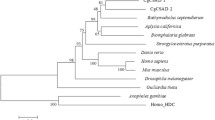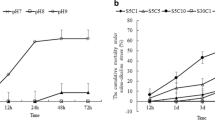Abstract
It has been suggested that invertebrates inhabiting deep-sea hydrothermal vent areas use the sulfinic acid hypotaurine, a precursor of taurine, to protect against the toxicity of hydrogen sulfide contained in the seawater from the vent. In this protective system, hypotaurine is accumulated in the gill, the primary site of sulfide exposure. However, the pathway for hypotaurine synthesis in mollusks has not been identified. In this study, we screened for the mRNAs of enzymes involved in hypotaurine synthesis in the deep-sea mussel Bathymodiolus septemdierum and cloned cDNAs encoding cysteine dioxygenase and cysteine sulfinate decarboxylase. As mRNAs encoding cysteamine dioxygenase and cysteine lyase were not detected, the cysteine sulfinate pathway is suggested to be the major pathway of hypotaurine and taurine synthesis. The two genes were found to be expressed in all the tissues examined, but the gill exhibited the highest expression. The mRNA level in the gill was not significantly changed by exposure to sulfides or thiosulfate. These results suggests that the gill of B. septemdierum maintains high levels of expression of the two genes regardless of ambient sulfide level and accumulates hypotaurine continuously to protect against sudden exposure to high level of sulfide.







Similar content being viewed by others
References
Allen K, Awapara J (1960) Metabolism of sulfur amino acids in Mytilus edulis and Rangia cuneata. Biol Bull 118:173–182
Bettencourt R, Pinheiro M, Egas C, Gomes P, Afonso M, Shark T, Santos R (2010) High-throughput sequencing and analysis of the gill tissue transcriptome from the deep-sea hydrothermal vet mussel Bathymodiolus azoricus. BMC Genom 11:559–576
Brand GL, Horak RV, Le Bris N, Goffredi SK, Carney SL, Govenar B, Yancey PH (2007) Hypotaurine and thiotaurine as indicators of sulfide exposure in bivalves and vestimentiferans from hydrothermal vents and cold seeps. Mar Ecol 28:208–218
Cavanaugh CM (1983) Symbiotic chemoautotrophic bacteria in marine invertebrates from sulfide-rich habitats. Nature 302:58–61
Dubilier N, Bergin C, Lott C (2008) Symbiotic diversity in marine animals: the art of harnessing chemosynthesis. Nat Rev Microbiol 6:725–740
Dunwell JM, Purvis A, Khuri S (2004) Cupins: the most functionally diverse protein superfamily? Phytochem 65:7–17
Duperron S, Gaudron SM, Rodrigues CF, Cunha MR, Decker C, Olu K (2013) An overview of chemosynthetic symbioses in bivalves from the North Altantic and Mediterranean Sea. Biogeosciences 10:3241–3267
Fogo JK, Popowsky M (1949) Spectrometric determination of hydrogen sulfide. Methylene blue method. Anal Chem 21:732–734
Fujinoki M, Koito T, Nemoto S, Kitada M, Yamaguchi Y, Hyodo S, Numanami H, Miyazaki N, Inoue K (2012) Comparison of the amount of thiotrophic symbionts in the deep-sea mussel Bathymodiolus septemdierum under different sulfide levels by using fluorescent in situ hybridization. Fish Sci 78:139–146
Gamo T, Ishibashi J, Tsunogai U, Okamura K, Chiba H (2006) Unique geochemistry of submarine hydrothermal fluids from arc˗back–arc setting of the western Pacific. In: Christie DM, Fisher CR, Lee S-M, Givens S (eds) Back-arc spreading systems: geological, biological, chemical, and physical interactions, Geophysical Monograph Series 166. American Geophysical Union, Washington, DC, pp 147–161
Inoue K, Tsukuda K, Koito T, Miyazaki Y, Hosoi M, Kado R, Miyazaki N, Toyohara H (2008) Possible role of a taurine transporter in the deep-sea mussel Bathymodiolus septemdierum in adaptation to hydrothermal vents. FEBS Lett 582:1542–1546
Jackson FR (1990) Prokaryotic and eukaryotic pyridoxal-dependent decarboxylases are homologous. J Mol Evol 31:325–329
Kinjo A, Koito T, Kawaguchi S, Inoue K (2013) Evolutionary history of the GABA transporter (GAT) group revealed by marine invertebrate GAT-1. PLoS One 8:e82410
Koito T, Morimoto S, Toyohara H, Yoshida T, Jimbo M, Maruyama T, Miyazaki N, Inoue K (2010a) Decline in taurine transporter mRNA and thioautotrophic bacterial 16S rDNA levels after transplantation of the hydrothermal-vent mussel Bathymodiolus septemdierum to a non-vent position Cah. Biol Mar 51:429–433
Koito T, Nakamura-Kusakabe I, Yoshida T, Maruyama T, Omata T, Miyazaki N, Inoue K (2010b) Effect of long-term exposure to sulfides on taurine transporter gene expression in the gill of the deep-sea mussel Bathymodiolus platifrons, which harbors a methanotrophic symbiont. Fish Sci 76:381–388
Lorion J, Kiel S, Faure B, Kawato M, Ho SYW, Marchall B, Tsuchida S, Miyazaki J, Fujiwara Y (2013) Adaptive radiation of chemosymbiotic deep-sea mussels. Proc R Soc B 280:20131243
Martins E, Queiroz A, Serrao Santos R, Bettencourt R (2013) Finding immune gene expression differences induced by marine bacterial pathogens in the deep-sea hydrothermal vent mussel Bathymodiolus azoricus. Biogeosci Discuss 10:2675–2703
Meng J, Zhu Q, Zhang L, Li C, Li L, She Z, Huang B, Zhang G (2013) Genome and transcriptome analyses provide insight into the euryhaline adaptation mechanism of Crassostrea gigas. PLoS One 8:e58563
Ortega JA, Ortega JM, Julian D (2008) Hypotaurine and sulfhydryl-containing antioxidants reduce H2S toxicity in erythrocytes from a marine invertebrate. J Exp Biol 211:3816–3825
Ouchi S (1959) 2-Aminoethanesulfinic acid. I. Isolation from a mollusc; identification and distribution. J Biochem 46:765–769
Pruski AM, Fiala-Médioni A, Fisher CR, Colomines JC (2000) Composition of free amino acids and related compounds in invertebrates with symbiotic bacteria at hydrocarbon seeps in the Gulf of Mexico. Mar Biol 136:411–420
Pruski AM, Fiala-Médioni A (2003) Stimulatory effect of sulphide on thiotaurine synthesis in three hydrothermal-vent species from East Pacific Rise. J Exp Biol 206:2923–2930
Rogers AD, Tyler PA, Connelly DP, Copley JT, James R, Larter RD, Linse K, Mills RA, Garabato AN, Pancost RD, Pearce DA, Polunin NVC, German CR, Shank T, Boersch-Supan PH, Alker BJ, Aquilina A, Bennett SA, Clarke A, Dinley RJJ, Graham AGC, Green DRH, Hawkes JA, Hepburn L, Hilario A, Huvenne VAI, Marsh L, Ramirez-Llodra E, Reid WDK, Roterman CN, Sweeting CJ, Thatje S, Zwirglmaier K (2012) The discovery of new deep-Sea hydrothermal vent communities in the Southern Ocean and implications for biogeography. Plos Biol 10:e1001234
Rosenberg NK, Lee RW, Yancey PH (2006) High contents of hypotaurine and thiotaurine in hydrothermal-vent gastropods without thiotrophic endosymbionts. J Exp Zool 305A:655–662
Sandmeier E, Hale TI, Christen P (1994) Multiple evolutionary origin of pyridoxal-5′-phosphate-dependent amino acid decarboxylases. Eur J Biochem 221:997–1002
Sen A, Becker EL, Podowski EL, Wickes LN, Ma S, Mullaugh KM, Hourdez S, Luther GW, Fisher CR (2013) Distribution of mega fauna on sulfide edifices on the Eastern Lau Spreading Center and Valu Fa Ridge. Deep-sea Res I 72:48–60
Stipanuk MH (2004) Role of the liver in regulation of body cysteine and taurine levels: a brief review. Neurochem Res 29:105–110
Stipanuk MH, Chad R, Simmons P, Karplus A, Dominy JE Jr (2011) Thiol dioxygenases: unique families of cupin proteins. Amino Acids 41:91–102
Tamura K, Stecher G, Peterson D, Filipski A, Kumar S (2013) MEGA6: molecular evolutionary genetics analysis version 6.0. Mol Biol Evol 30:2725–2729
Thubaut J, Puillandre N, Faure B, Cruaud C, Samadi S (2013) The contrasted evolutionary fates of deep-sea chemosynthetic mussels (Bivalvia, Bathymodiolinae). Ecol Evol 3:4748–4766
Ubuka T, Okada A, Nakamura H (2008) Production of hypotaurine from L-cysteinesulfinate by rat liver mitochondria. Amino Acids 35:53–58
Ueki I, Stipanuk MH (2009) 3T3-L1 Adipocytes and rat adipose tissue have a high capacity for taurine synthesis by the cysteine dioxygenase/cysteinesulfinate decarboxylase and cysteamine dioxygenase pathways. J Nutr 139:207–214
Ueki I, Roman HB, Hirschberger LL, Junior C, Stipanuk MH (2012) Extrahepatic tissues compensate for loss of hepatic taurine synthesis in mice with liver-specific knockout of cysteine dioxygenase. Am J Physiol Endocrinol Metab 302:E1292–E1299
Van Dover CL, Lutz RA (2004) Experimental ecology at deep-sea hydrothermal vents: a perspective. J Exp Mar Biol Ecol 300:273–307
Vitvitsky V, Garg SK, Banerjee R (2011) Taurine biosynthesis by neurons and astrocytes. J Biol Chem 286:32002–32010
Waite TJ, Moore TS, Childress JJ, Hsu-Kim H, Mullaugh KM, Nuzzio DB, Paschal AN, Tsang J, Fisher CR, Luther GWL III (2008) Variation in sulfur speciation with shellfish presence at a Lau basin diffuse flow vent site. J Shellfish Res 27:163–168
Wang R (2012) Physiological implications of hydrogen sulfide: a whiff exploration that blossomed. Physiol Rev 92:791–896
Yancey PH, Ishikawa J, Meyer B, Girguis PR, Lee RW (2009) Thiotaurine and hypotaurine contents in hydrothermal-vent polychaetes without thiotrophic endosymbionts: correlation with sulfide exposure. J Exp Zool 311A:439–447
Yoneda T (1968) Enzymatic oxidation of cysteine to taurine in marine mollusk, Mytilus edulis. Bull Fac Fish Hokkaido Univ 19:140–146
Zhang G, Fang X, Guo X, Li L, Luo R, Xu F, Yang P, Zhang L, Wang X, Qi H, Xiong Z, Que H, Xie Y, Holland PW, Paps J, Zhu Y, Wu F, Chen Y, Wang J, Peng C, Meng J, Yang L, Liu J, Wen B, Zhang N, Huang Z, Zhu Q, Feng Y, Mount A, Hedgecock D, Xu Z, Liu Y, Domazet-Lošo T, Du Y, Sun X, Zhang S, Liu B, Cheng P, Jiang X, Li J, Fan D, Wang W, Fu W, Wang T, Wang B, Zhang J, Peng Z, Li Y, Li N, Wang J, Chen M, He Y, Tan F, Song X, Zheng Q, Huang R, Yang H, Du X, Chen L, Yang M, Gaffney PM, Wang S, Luo L, She Z, Ming Y, Huang W, Zhang S, Huang B, Zhang Y, Qu T, Ni P, Miao G, Wang J, Wang Q, Steinberg CE, Wang H, Li N, Qian L, Zhang G, Li Y, Yang H, Liu X, Wang J, Yin Y, Wang J (2012) The oyster genome reveals stress adaptation and complexity of shell formation. Nature 490:49–54
Acknowledgments
The authors thank Dr. Christopher A. Loretz for critical reading the manuscript and Prof. Toshitaka Gamo for information on chemical components of hydrothermal fluids. The authors also thank the operating team of ROV Hyper-Dolphin and the crew of the R/V Natsushima of JAMSTEC. This work was supported by Japan Society for the Promotion of Science KAKENHI No. 22380107.
Conflict of interest
The authors declare that they have no conflict of interest with respect to this manuscript.
Author information
Authors and Affiliations
Corresponding author
Rights and permissions
About this article
Cite this article
Nagasaki, T., Hongo, Y., Koito, T. et al. Cysteine dioxygenase and cysteine sulfinate decarboxylase genes of the deep-sea mussel Bathymodiolus septemdierum: possible involvement in hypotaurine synthesis and adaptation to hydrogen sulfide. Amino Acids 47, 571–578 (2015). https://doi.org/10.1007/s00726-014-1891-z
Received:
Accepted:
Published:
Issue Date:
DOI: https://doi.org/10.1007/s00726-014-1891-z




